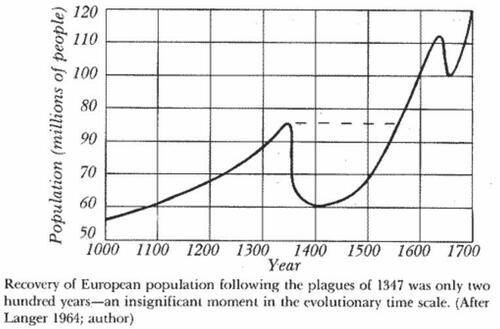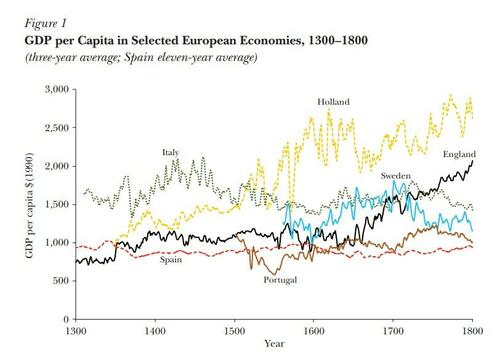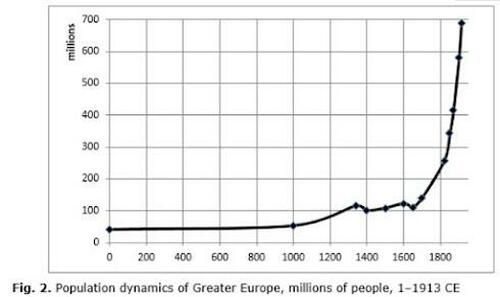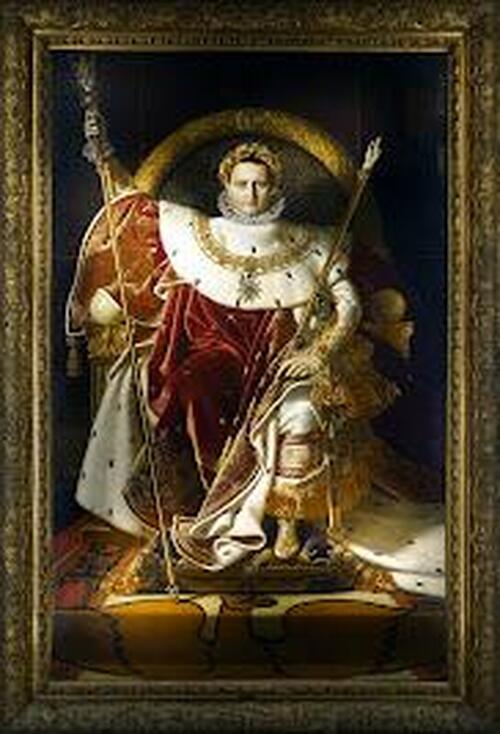Results 1 to 1 of 1
Thread Information
Users Browsing this Thread
There are currently 1 users browsing this thread. (0 members and 1 guests)
-
12-15-2022, 04:08 AM #1
The End Of Europe: The Conclusion Of A Long Historical Cycle
The End Of Europe: The Conclusion Of A Long Historical Cycle
THURSDAY, DEC 15, 2022 - 02:00 AM
Authored by Ugo Bardi via SenecaEffect.com,
The failure of the European Union may have started with the choice of the flag. Not that state flags are supposed to be works of art, but at least they can be inspiring. But this flag is completely flat, unoriginal, and depressing. It looks mostly like a blue cheese pizza gone bad. And that's just one of the many things gone bad with the European Union. (attempts to make it more appealing failed utterly). It is the conclusion of a thousand-year cycle that's coming to an end. It was probably unavoidable, but that doesn't make it less painful.

Europe has a long history that goes back to when the ice sheets retreated at the end of the last ice age, some 10,000 years ago. At that time, our remote ancestors moved into a pristine land, cultivated it, built villages, roads, and cities. They traveled, migrated, fought each other, created cultures, built temples, fortresses, and palaces. On the Southern coast of Europe, a lively network of commercial exchanges emerged, made possible by maritime transportation over the Mediterranean Sea. Out of this network, the Roman Empire was born around the end of the first millennium BCE. It included most of Western Europe. (image from ESA)

As all empires do, the Roman Empire went through its cycle of glory and decline. In the 5th century AD, as Europe entered the Middle Ages, the Empire had disappeared except as a memory of past greatness. In the following centuries, the population of Western Europe declined to a historical minimum, maybe less than 20 million people. Europe became a land of thick forests, portentous ruins, small villages, and petty warlords fighting each other. No one could have imagined that, centuries later, Europeans would become the dominators of the world.
Sometimes, collapses bring with them the seed of recovery. It is what I called the "Seneca Rebound." For some reason, we moderns disparage the Middle Ages, calling the era the "Dark Ages." But there was nothing dark during the European Middle Ages. Europe was poor in material terms, but Europeans managed to create a culture of refined literature, splendid cathedrals, sophisticated music, advanced technologies, and much more. One reason for the prospering of the European culture was the presence of tools that other regions of the world lacked. One was the Latin language, used to keep alive the ancient Classical Culture and its achievements. It also helped trade and created strong cultural bonds all over the continent. Europeans also inherited the bulk of Roman law and culture, and Roman technologies in fields such as metallurgy and weapon making.
With Europe recovering from the 5th-century collapse, new precious metal mines in Eastern Europe started pumping wealth into the continent. The result was explosive. Already in 800 AD, Charlemagne, King of the Franks, could assemble an army powerful enough to create a new Europe-wide Empire, the "Sacred Roman Empire." With the turn of the millennium, the European population was rapidly growing, and it needed space to expand. Europe was a coiled spring, ready to snap. In 1095, a burst of armies emerged out of Europe, crashing into the Near East. It was the time of the Crusades.
Initially, the invasion of the Middle East was a spectacular success: the Christian armies defeated the local rulers, established new kingdoms, and recreated a direct commercial connection with East Asia, along the Silk Road. But the task was too huge for a still young Europe. After two centuries of struggle, the European armies were forced to abandon the Holy Land, defeated and in disarray. At this point, Europe faced again the problem it had tried to solve with the Crusades: overpopulation. The problem solved itself by means of a quick population collapse, first with the great famine (1315Ė1317), then the black plague. The Europe of the 13th century was so weakened that it seriously risked being overcome by the Mongol armies coming from Asia. Fortunately for the Europeans, the Mongols couldn't sustain a full-scale attack so far from the center of their Empire.

A schematic view of the European population during about one millennium. Note the two collapses: both have the typical "Seneca-Shape," that is, decline is faster than growth. The first collapse was caused by famine and by the black plague, the second by the 30-year war, and the associated plagues and famines.
Despite the ravages of the Black Plague, Europe emerged out of it with its culture, social structure, and technological knowledge still intact. Europe didn't just recover, but it rebounded in a spectacular way. Shipbuilding technologies were improved, allowing Europeans to sail across the oceans. During their internecine quarrels, the Europeans had also turned firearms into terribly effective weapons. During the 16th and 17th centuries, they rebuffed the attempts of the Ottoman Empire to expand into Europe. The Ottomans were dealt a crushing blow on the sea at Lepanto, in 1571. Then, they were decisively defeated on land at the siege of Vienna, in 1683. With their Eastern Borders now safe, Europeans had a free hand to expand overseas.
The 16th century saw the birth of a pattern that would persist for several centuries. European armies would invade foreign kingdoms, crush all military resistance, and replace the native leaders with European ones. Sometimes they used the local inhabitants as slaves, sometimes they wiped them out and replaced them with European colonists. The new lands were an incredible source of wealth. Europe imported precious metals, timber, spice, and even food in the form of sugar produced from sugarcane. The inflow of gold and silver from overseas stimulated the European economy, and timber allowed Europeans to build more ships. And the imports of food allowed the European population to grow and to field new armies that could conquer new lands that produced even more food.
Nevertheless, Europe's expansion started to slow down in the 17th century. The 30 years war, 1618 to 1648, was a terrible disaster that may have exterminated 10% of the European population. Then, as usual with wars, another outburst of plague followed. Europe seemed to have reached a new limit to its expansion. Sugar was not enough, by itself, to sustain the need for materials to keep and further expand the European empire. Wood was needed to produce ships and, at the same time, to be turned into the charcoal needed to smelt metals. But trees were depleted in Europe and importing timber from overseas was expensive. Most of the Southern European countries saw their forests decline and their growth stall.

(image from Foquet and Bradberry). (France is not shown in the figure, but it shows a pattern similar to that of England).
Despite the troubles, the Northern European economies, (especially England) rapidly restarted to grow after the 17th-century crisis. The trick was a new technological development: coal. Coal had already been used as a fuel in Roman times, but nobody in history had used it on such a large scale. With coal, Europeans didn't need anymore to destroy their forests to make iron. That was the start of a new, successful rebound. By the early 20th century, Europe dominated the whole world, directly or indirectly.

Europe's population according to Zinkina et al. (2017). The two drops of the 14th and the 17th century are clearly visible, although less dramatic on this scale than in the earlier work of Langer
As typical of empires, with the conquests completed, there came a time of consolidation. No more risky adventures of individual states, but a central government to manage the empire and keep it together. For the ancient Romans, it had been the task of Julius Caesar to create a strong, centralized state. For modern Europe, it was a much more difficult story: how to tame a group of quarrelsome states that seemed to spend most of their time fighting each other?
The Holy Roman Emperor, Charles 5th (1500-155 , was among the first to try, without success. His successor, Philip 2nd of Spain (1527- 159
, was among the first to try, without success. His successor, Philip 2nd of Spain (1527- 159 , tried to subdue Britain with his "invincible armada" in 1588, but he failed, too. The decline of Spain left space for other European powers to try again. Napoleon Bonaparte (1769 -1821) almost succeeded, but his imperial dreams sank at Trafalgar and then froze to death in the Russian plains. Then, it was the turn of Germany. The attempt started in 1914, and again in 1939. In both cases, it was a tragic failure. Even the weak Italy had imperial dreams. In the 1940s, Benito Mussolini attempted to recreate a new version of the ancient Roman Empire in the Mediterranean Sea. Utter failure, again.
, tried to subdue Britain with his "invincible armada" in 1588, but he failed, too. The decline of Spain left space for other European powers to try again. Napoleon Bonaparte (1769 -1821) almost succeeded, but his imperial dreams sank at Trafalgar and then froze to death in the Russian plains. Then, it was the turn of Germany. The attempt started in 1914, and again in 1939. In both cases, it was a tragic failure. Even the weak Italy had imperial dreams. In the 1940s, Benito Mussolini attempted to recreate a new version of the ancient Roman Empire in the Mediterranean Sea. Utter failure, again.

Over and over, the would-be European Imperial powers found themselves facing an impossible challenge. In the West, Britain had no interest in seeing a European Empire arising just on the other side of the Channel. The same was true for the East, with Russia not keen to see a major power near its borders. The result was that the European armies found themselves fighting on two sides at the same time. Then, the Mediterranean Sea was in the iron grip of the British Navy -- no way for continental powers to expand South. With the end of WW2, Europe emerged out of the struggle destroyed, impoverished, and humiliated.
The latest (and perhaps the last) attempt to unify Europe was the European Union. The creators of the Union understood that it was impossible to unify Europe by military means, so they tried to do it in the form of an economic free zone and an elected parliament. It was a bold attempt, but it didn't work. It could not have worked. The Union faced enormous hostile forces, both internal and external. Britain and France were supposed to be balancing the German power, but when Britain left, in 2020, the Union suffered an economic defeat equivalent to the military one suffered by Germany in the Battle of Britain, in 1940. In both cases, they had tried to absorb Britain into continental Europe, and they had failed.
The defection of Britain left the European Union with Germany dominating it. Just like during WW2, the German government never understood that throwing its weight around was not the way to endear itself with the neighboring states. The result was the growth of anti-European forces all over the continent -- the movement called "sovereignty" that aimed to restore the power of nation-states and get rid of the EU bureaucrats. So far, this movement has played only a marginal role in politics, but it has succeeded in making the EU deeply hated by everyone who is not getting their salaries from Brussels.
Just as it had happened in 1941, Europe is now engaged in a desperate battle on two different fronts, but the struggle is now mainly economic and cultural, not military: it is a "full spectrum dominance" war. The struggle is still ongoing, but it seems already clear that Europe is being defeated. Just like Germany had destroyed itself with a military attack on Russia in 1941, the European Union is destroying itself with its economic sanctions against Russia. Effectively, Europe is committing a slow and painful suicide. But that's how full spectrum dominance works: it destroys enemies from the inside.
And now? It was unavoidable that Europe would cease to be an Empire. The human and material resources that had made European dominance possible are not there any longer. But it was not unavoidable that Europe would destroy itself. Europe could have survived and maintained its independence by remaining on good terms with the other Eurasiatic powers, China, Russia, and India, But, choosing to break the commercial, cultural, and human relations with the rest of Eurasia was not just an economic suicide. It was a cultural and moral suicide.
So, what's going to happen to poor Europe? History, as usual, rhymes: do not forget that in 1945 the official US plan was to destroy the German economy and exterminate most of the German population. Fortunately, the plan was shelved, but could that idea become fashionable again? We cannot exclude this possibility. In any case, an impoverished Europe could go back to something not unlike what it was during the early Middle Ages: depopulated, poor, primitive, a mere appendage of the great Eurasian Continent.
And, yet, Europe has rebounded more than once from terrible disasters. It may happen again. Not soon, though.

As inspiring as a blue cheese pizza gone bad
The End Of Europe: The Conclusion Of A Long Historical Cycle | ZeroHedge
If you're gonna fight, fight like you're the third monkey on the ramp to Noah's Ark... and brother its starting to rain. Join our efforts to Secure America's Borders and End Illegal Immigration by Joining ALIPAC's E-Mail Alerts network (CLICK HERE)
Similar Threads
-
Europe reveals long list of US exports it could hit
By Judy in forum Other Topics News and IssuesReplies: 1Last Post: 03-16-2018, 12:54 PM -
Detroit Is Socialismís Logical Conclusion
By kathyet in forum Other Topics News and IssuesReplies: 0Last Post: 12-13-2012, 04:18 PM -
They Know Social Unrest is a Foregone Conclusion
By AirborneSapper7 in forum Other Topics News and IssuesReplies: 0Last Post: 11-22-2011, 10:29 PM -
WW3 A Foregone Conclusion? The Whole Plan For NWO
By AirborneSapper7 in forum Other Topics News and IssuesReplies: 2Last Post: 11-06-2011, 10:37 PM -
Long Winter of 2010-2011 The end of the cooling cycle is no
By AirborneSapper7 in forum Other Topics News and IssuesReplies: 0Last Post: 01-28-2011, 03:23 AM


 LinkBack URL
LinkBack URL About LinkBacks
About LinkBacks




 Reply With Quote
Reply With Quote


Durbin pushes voting rights for illegal aliens without public...
04-25-2024, 09:10 PM in Non-Citizen & illegal migrant voters